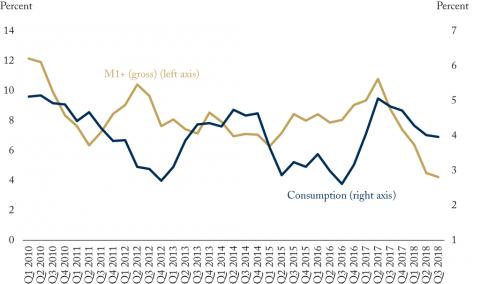From: William B.P. Robson and Jeremy M. Kronick
To: Governing Council, Bank of Canada
Date: January 09, 2019
Re: Money Growth in Canada is Ominously Weak
Something weird has happened to Canada’s money supply. Growth in the measures of money the Bank of Canada highlights on its website, currency plus various types of deposits and liquid financial instruments people hold mainly for transactions, has collapsed since 2017. Two of the Bank’s highlighted measures, M1+ and M1++, are growing at their slowest rates since the financial crisis a decade ago.
Is this weak money growth signaling a slumping economy?
Back in the 1970s and 1980s, many people would have said “yes” – as they would have also said if asked whether acceleration of the money supply heralded an inflationary boom. Monetarists convincingly pointed to rapid money growth as the culprit behind the inflation of the late 1970s, and US Federal Reserve Chairman Paul Volcker famously choked money growth to bring inflation down in the early 1980s.
Since then, however, financial innovations and the descent of interest rates to historic lows have loosened the links between money, spending and inflation. There is an adage in economics that as soon as policymakers start to target a measure, the measure stops being a good target. Money is a prime example. As Gerald Bouey, Bank of Canada Governor in the late 1980s, put it: “we didn’t abandon M1, M1 abandoned us!” Nowadays, central bankers and macroeconomists pay much less attention to the money supply.
Just because policymakers stop targeting a measure does not mean that it will become a good target again. Nevertheless, the recent behaviour of money in Canada is suggestive. At the beginning of 2014, the Bank’s highlighted monetary aggregates were growing between 6 and 8 percent year-over-year (The Figure highlights M1+, at 7.9 percent in Q1 2014). Between then and early 2017, the pace picked up – two of the three hit 10-percent-plus rates. Consumption spending also accelerated during that period, and, as earlier money-watchers would have predicted, the Canadian economy grew robustly.
Since the spring of 2017, however, growth rates of all three aggregates have cratered: narrow aggregate growth now sits at 4.2 and 2.8 percent, with broad growth at only 4.9 percent.
Tighter monetary policy is a reasonable explanation for falling money growth in one straightforward sense. The Bank has increased its overnight rate by 125 basis points since June 2017. When interest rates are higher, people economize on their holdings of currency and deposits that pay low or no interest. So the velocity of circulation rises: each dollar of transactions money works a bit harder. But such a modest increase in short-term interest rates seems unlikely to fully explain such an off-the-cliff change in money growth.
On its face, this collapse in money growth suggests that consumption spending, and Canadian economic growth overall, will be weak heading into 2019. Plenty of other indicators point the same way: global growth is slowing, political risks abound, and sharp declines in share prices have spooked savers. Lower commodity prices and a sharp decline in inflation expectations are, from the Bank of Canada’s perspective, further decisive arguments in favour of holding the line on interest-rate increases for the time being. The message from Canada’s money supply is that our economy is cooling off on its own.
William B.P. Robson is President and CEO of the C.D. Howe Institute and Jeremy M. Kronick is Associate Director, Research, at the C.D. Howe Institute.
To send a comment or leave feedback, email us at blog@cdhowe.org.
The views expressed here are those of the authors. The C.D. Howe Institute does not take corporate positions on policy matters.






